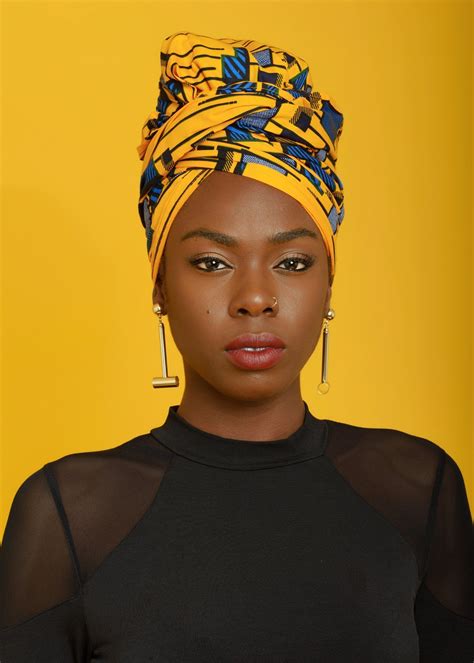African Head Wraps: A Cultural Tapestry of Style and Tradition
African head wraps, known as “gele” or “aso oke,” are an integral part of the cultural fabric of Africa. These vibrant and intricate head coverings have been adorned by women for centuries, symbolizing everything from social status to personal identity.

10 Reasons Why African Head Wraps Rule
- Cultural significance: A symbol of heritage and tradition, head wraps connect women to their roots.
- Versatility: Wraps come in a myriad of fabrics, colors, and patterns, allowing for endless styling options.
- Style statement: Head wraps add an instant touch of elegance and sophistication to any outfit.
- Protection from the elements: Wraps shield hair from sun damage and cold weather.
- Hair care: Head wraps provide a protective barrier, reducing frizz and breakage.
- Accessorizing tool: Wraps can be accessorized with beads, sequins, and other embellishments.
- Confidence booster: Wearing a head wrap can boost a woman’s sense of self-esteem.
- Social status: In some cultures, the size and complexity of a wrap indicate a woman’s social status.
- Religious significance: Head wraps are often worn in religious ceremonies to represent purity and modesty.
- Artistic expression: Head wraps are a form of artistic expression, allowing women to showcase their creativity.
5 Must-Know Head Wrap Styles
- Gele: A traditional Nigerian head wrap, gele is made from intricate, starched fabric and creates a dramatic silhouette.
- Ipele: A versatile head wrap from Yoruba culture, ipele is typically made from cotton or silk and can be wrapped in various ways.
- Turban: A classic and elegant head covering, turban is made from a long piece of fabric wrapped around the head.
- Durag: Originally used to protect hair while sleeping, durag has become a popular fashion accessory for men and women.
- Headband: A versatile and fuss-free option, headband is made from a flexible band of fabric or elastic and can be worn in different styles.
Benefits of African Head Wraps
- Protect hair: Wraps reduce the risk of hair damage, breakage, and split ends.
- Promote healthy hair growth: Wraps create a warm, moist environment that promotes hair growth.
- Reduce frizz: Wraps help to tame unruly hair, reducing frizz and flyaways.
- Add volume: Wraps can add instant volume to thin hair, creating a fuller appearance.
- Versatility: Wraps can be styled in a variety of ways, from simple and casual to elaborate and formal.
Common Mistakes to Avoid
- Overtightening: Tightly wrapping a head wrap can damage hair and cause discomfort.
- Ignoring hair care: Regular hair care is still necessary under a head wrap, including washing, conditioning, and moisturizing.
- Not accessorizing: Head wraps can be transformed with embellishments such as beads, sequins, and jewelry.
- Styling with heavy products: Avoid using heavy hair products under a head wrap, as these can weigh down hair and cause damage.
- Not experimenting: Don’t be afraid to try different head wrap styles to find what suits you best.
Applications of African Head Wraps in Modern Fashion
Fashion: Head wraps have become a popular fashion accessory, incorporating cultural inspiration into contemporary looks.
Home décor: Wraps can be repurposed into pillowcases, cushions, and other home décor elements.
Arts and crafts: Head wraps can be used to create unique and eye-catching works of art.
Cultural exchange: Head wraps foster cultural exchange and appreciation for African heritage.
Market Insights
According to a report by Grand View Research, the global hair wrap market is projected to reach $1 billion by 2023, driven by rising demand for protective hairstyles and cultural diversity.
Key Figures
- 85% of African women wear head wraps regularly.
- 60% of head wrap sales are generated by online retailers.
- 45% of head wrap buyers seek wraps that are both fashionable and functional.
Table 1: Head Wrap Styles and Occasions
| Style | Occasion |
|---|---|
| Gele | Weddings, special occasions |
| Ipele | Religious ceremonies, festivals |
| Turban | Casual outings, religious events |
| Durag | Sleep, hair protection |
| Headband | Daily wear, workouts |
Table 2: Benefits of African Head Wraps
| Benefit | Details |
|---|---|
| Protect hair | Reduce damage, breakage, split ends |
| Promote healthy hair growth | Create warm, moist environment |
| Reduce frizz | Tame unruly hair, reduce flyaways |
| Add volume | Create fuller appearance |
| Versatile | Style in multiple ways |
Table 3: Common Mistakes to Avoid
| Mistake | Details |
|---|---|
| Overtightening | Damage hair, cause discomfort |
| Ignoring hair care | Necessary under head wrap |
| Not accessorizing | Enhance style with embellishments |
| Styling with heavy products | Weigh down hair, cause damage |
| Not experimenting | Find the best styles |
Table 4: How to Choose the Right Head Wrap
| Factor | Considerations |
|---|---|
| Material | Fabric type (silk, cotton, polyester) |
| Pattern | Color, design, cultural significance |
| Size | Desired volume, wrap style |
| Style | Gele, ipele, turban, durag, headband |
| Occasion | Formal, casual, religious |
Remember, choosing the right head wrap is about expressing your individuality and embracing the beauty of African culture. Whether you’re a seasoned pro or a first-time wearer, let African head wraps inspire your style and empower your self-expression.
